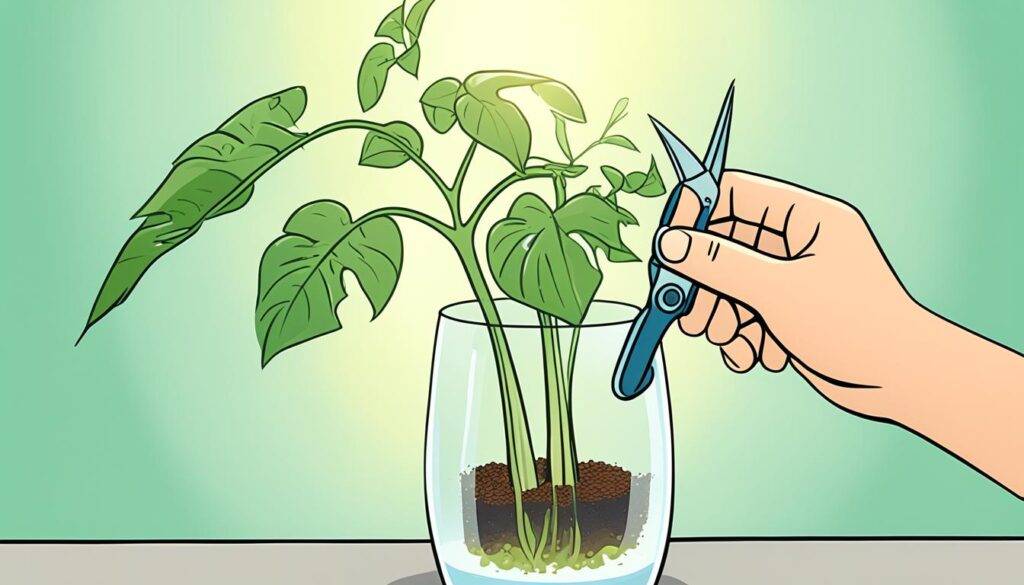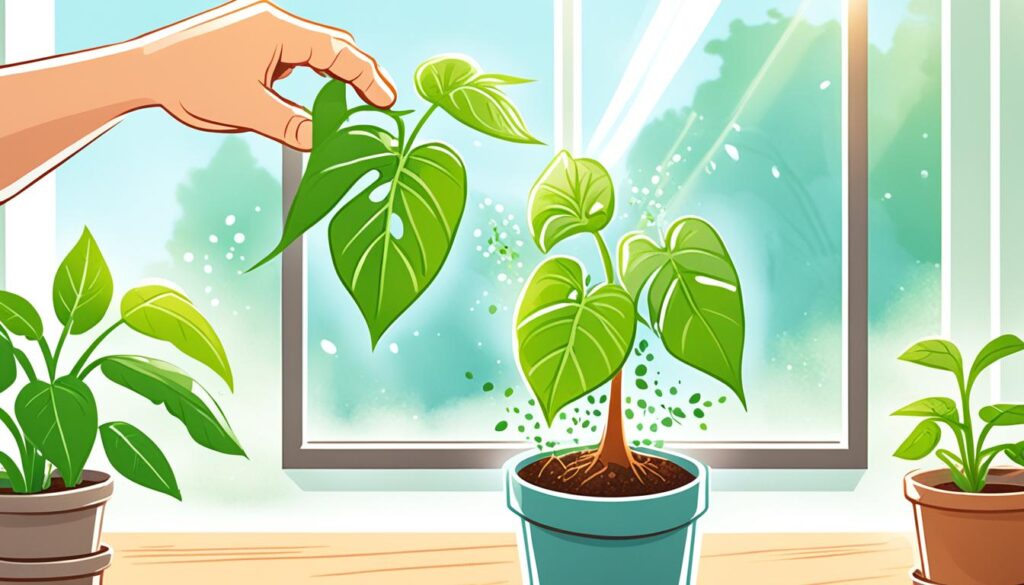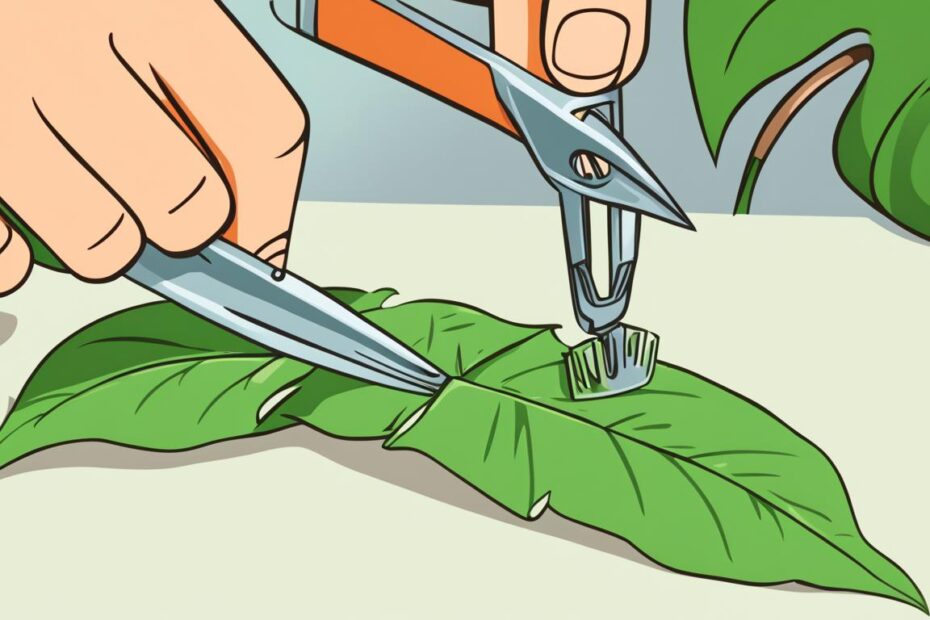Have you ever wondered how to propagate philodendron in soil? Or maybe you’ve heard that it’s a difficult and time-consuming process. Well, I’m here to tell you that propagating philodendron in soil is actually quite easy! Say goodbye to expensive nursery plants and hello to a thriving indoor garden. So, are you ready to learn the secrets of propagating philodendron in soil? Let’s dive in!
Key Takeaways:
- Propagating philodendron in soil is a simple and rewarding process.
- Choose healthy stems from a mature plant and take cuttings that are about six inches long.
- Plant the cuttings in moistened potting mix and keep the soil evenly moist for the first week.
- Roots will develop in a few weeks, and new growth should appear within a month.
- By propagating philodendron in soil, you can expand your indoor garden and enjoy the beauty of this lush houseplant.
Growing and Caring for Heart-Leaf Philodendron
Heart-leaf philodendron is a popular variety known for its elegant heart-shaped leaves and trailing growth habit. This low-maintenance houseplant thrives in a variety of indoor conditions, making it a perfect choice for any plant lover. To keep your heart-leaf philodendron happy and healthy, here are some essential care tips:
- Light: Provide bright, indirect light for your philodendron. Avoid direct sunlight, as it can scorch the leaves. Place your plant near a window with filtered light, or use sheer curtains to protect it from intense sunlight.
- Water: Water your heart-leaf philodendron when the top inch of soil feels dry. Be careful not to overwater, as this can lead to root rot. Inadequate watering can cause the leaves to droop. Aim for a balance and adjust watering frequency based on the specific needs of your plant.
- Humidity: Heart-leaf philodendrons thrive in higher humidity levels. If your indoor environment is dry, consider misting the leaves regularly or placing a humidifier nearby. This will help recreate their preferred tropical climate.
- Temperature: Heart-leaf philodendrons prefer temperatures between 65°F and 80°F (18°C to 27°C). Keep the plant away from drafts or extreme temperature changes, as they can cause stress and damage the leaves.
- Fertilizer: Feed your heart-leaf philodendron with a balanced liquid fertilizer every two to three weeks during the growing season (spring and summer). Follow the package instructions for the correct dilution ratio, as over-fertilizing can harm the plant.
- Pruning: Prune your heart-leaf philodendron in spring or summer to maintain its shape and encourage new growth. Remove any yellowing or dead leaves to promote better overall health.
Heart-leaf philodendrons are relatively resistant to pests, but it’s always a good idea to keep an eye out for common houseplant insects such as spider mites or aphids. If you notice any signs of infestation, treat the plant promptly with an appropriate insecticidal soap or natural remedy.
Remember, each heart-leaf philodendron is unique, and their care needs may vary slightly. Pay attention to the specific requirements of your plant and adjust your care routine accordingly. With proper attention and love, your heart-leaf philodendron will continue to grace your home with its stunning foliage for years to come.
Propagating Philodendron in Water
Philodendron can be easily propagated in water by taking stem cuttings. After selecting healthy stems with several leaves, remove the lower leaves and place the cuttings in a jar or glass filled with water.
Keep the cuttings in a warm place with bright, indirect light and change the water regularly. Roots will start to form in about a week or so. Once the roots are at least one inch long, the cuttings can be planted in soil.
Philodendron can be easily propagated in water by taking stem cuttings. After selecting healthy stems with several leaves, remove the lower leaves and place the cuttings in a jar or glass filled with water.
Keep the cuttings in a warm place with bright, indirect light and change the water regularly. Roots will start to form in about a week or so. Once the roots are at least one inch long, the cuttings can be planted in soil.

Propagating philodendron in water is a great option for beginners or for those who want to enjoy the beauty of the rooting process. Watching the roots grow and develop in water can be a rewarding experience. Additionally, propagating in water allows you to easily monitor the root growth and ensure that the cuttings are ready for transplantation.
Water propagation for philodendron is a simple and effective method that can yield successful results. It provides a safe and controlled environment for the cuttings to develop roots before being planted in soil. This method also allows you to propagate multiple cuttings at once, increasing your chances of success.
Propagating Philodendron in Soil
Propagating philodendron in soil is a simple and effective method of growing new plants from stem cuttings. By following these easy steps, you can successfully propagate your philodendron and expand your indoor garden.
To begin, select healthy stems from an established philodendron plant. Look for stems with several leaves and ensure they are free from any signs of damage or disease. Using clean and sharp pruners, cut the stems to about six inches in length.
Next, remove the lower leaves from the cuttings, leaving only a few leaves at the top. This helps to promote better root development and prevents the leaves from rotting when buried in the soil.
Prepare a small pot with moistened potting mix. You can use a well-draining mix specifically designed for houseplants or create your own by combining equal parts of peat moss, perlite, and vermiculite.
Plant the philodendron cuttings in the potting mix, making sure that the roots are below the soil line. Gently pat the soil around each stem to provide stability and ensure good soil-to-root contact.
Keep the soil evenly moist, but not waterlogged, for the first week to promote root growth. Avoid overwatering, as it can lead to root rot. After the first week, you can water the plant as usual, allowing the top inch of soil to dry out before watering again.
Place the pot in a warm location with bright, indirect light. Philodendrons prefer bright light but can be sensitive to direct sunlight, which may cause their leaves to burn.
Within a few weeks, roots will start to develop, and you should notice new growth emerging from the cuttings within a month. Once the new growth is well established, you can treat the propagated philodendron as you would any mature plant, providing it with appropriate care and maintenance.
By propagating philodendron in soil, you can easily expand your collection and share the beauty of this versatile houseplant with others. Enjoy the process of nurturing new growth and watching your philodendron thrive!

| Benefits of Soil Propagation | Benefits of Water Propagation |
|---|---|
|
|
Propagating Philodendron by Division
If you have an overgrown or mature philodendron plant, dividing it is another excellent method of propagation. This technique allows you to create new plants from the existing one, enabling you to expand your philodendron collection or share the joy of growing this beautiful houseplant with others. Here’s how you can propagate philodendron by division:
- Prepare the plant: Before you begin dividing your philodendron, water it thoroughly the day before. This will help loosen the soil, making it easier to separate the roots without causing damage.
- Remove the plant: Carefully remove the philodendron from its container, gently loosening the soil around the roots.
- Separate the roots: Gently separate the roots into two or more sections, ensuring that each section has at least two healthy roots. Be careful not to break or damage the roots during this process.
- Replant the main plant: Once you’ve separated the roots, replant the main plant back into its original container or a new pot with fresh, well-draining soil.
- Replant the divided sections: Set the other sections aside to be replanted in their own pots. Each section will have its own established root system, allowing them to grow independently.
- Provide proper care: Place the newly divided plants in a location with bright, indirect light and maintain regular watering. Within days, you’ll start to see new growth emerging from the divided sections.
Dividing your philodendron is a simple yet effective way to propagate and rejuvenate your plants. By following these steps, you can multiply your philodendron collection and enjoy the beauty of this stunning houseplant in different areas of your home.
| Advantages of Division Propagation | Disadvantages of Division Propagation |
|---|---|
| 1. Easy and straightforward process. | 1. Can damage the parent plant during division if not done carefully. |
| 2. Provides instant plants with established root systems. | 2. Limited number of new plants compared to other methods. |
| 3. Ideal for overgrown or mature plants that need rejuvenation. | 3. Some varieties may not divide as easily. |
| 4. Allows you to share plants with friends and family. | 4. Requires repotting and extra care for the divided sections. |
Conclusion
Propagating philodendron in soil is a rewarding and straightforward process. By following this propagate philodendron in soil guide, you can easily expand your indoor garden and enjoy the lush greenery and beauty of philodendron in your home.
Whether you choose to propagate your philodendron in water or soil, the key is to start with healthy stems. Select stems from mature and thriving plants, and take cuttings that are about six inches long.
Provide the right conditions for root development, such as bright indirect light and consistently moist soil. With proper care, patience, and a little bit of time, you will see roots starting to form and new growth emerging. Before you know it, you’ll have successfully propagated your philodendron plant!
FAQ
Can I propagate philodendron in soil?
Yes, philodendron can be easily propagated in soil by taking stem cuttings and planting them in potting mix.
When is the best time to propagate philodendron?
The best time to propagate philodendron is in spring or summer when the plant is actively growing.
How do I propagate philodendron in soil?
To propagate philodendron in soil, select healthy stems with several leaves, remove the lower leaves, and plant the cuttings in a small pot filled with moistened potting mix.
How long does it take for roots to develop when propagating philodendron in soil?
Roots will develop in a few weeks when propagating philodendron in soil, and new growth should appear within a month.
Can I propagate philodendron by division?
Yes, you can propagate philodendron by division. This method involves dividing an overgrown or mature plant into two or more sections, each with its own established root system.
How do I care for heart-leaf philodendron?
To care for heart-leaf philodendron, provide bright, indirect light, water the plant when the top inch of soil feels dry, and prune in spring or summer to maintain its shape and encourage new growth.
